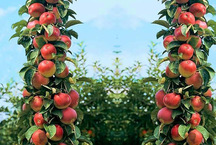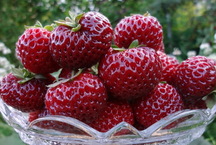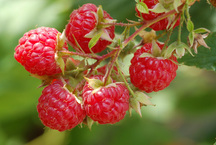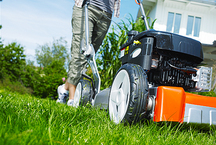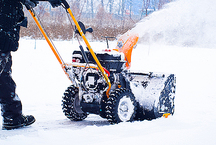Top 10 blackberry varieties
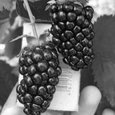




In the amateur gardens of Russia, blackberry is a rare guest, not to mention industrial cultivation. There is no or very little local fresh berries on the market, and frozen imported ones are devoid of flavor and taste. The growing popularity of the cultural form of blackberry is hampered by stereotypes about the sour taste of small berries and the increased pricklyness of the bush with aggressive growth. In fact, the good modern varieties of blackberry are beshipnye, and the berry is fragrant and sweet. The main task is to select a frost-resistant variety that has time to mature in a specific region. We present you a description of the best varieties of blackberry - according to experienced gardeners.
In the middle zone and the suburbs, blackberries are grown with shelter. For varieties with fragile, tough and erect shoots, it is necessary to limit the growth of replacement shoots by pinching the top. Such a procedure will facilitate bending down and shelter for the winter. Features of the formation and type of shelter (bending down, non-web, non-web + ground) depends on the region of cultivation.
Rating the best varieties of blackberry
| A place | Name | Rating | Price |
|---|---|---|---|
| 1 | Loch tey | 9.9 / 10 | 350 |
| 2 | Prime Ark Freedom | 9.8 / 10 | 550 |
| 3 | Chester | 9.8 / 10 | 480 |
| 4 | Polar | 9.8 / 10 | 350 |
| 5 | Natchez | 9.8 / 10 | 500 |
| 6 | Thornless Evergreen | 9.8 / 10 | 1 000 |
| 7 | Guy | 9.8 / 10 | 350 |
| 8 | Tornfree | 9.7 / 10 | 490 |
| 9 | Karaka Black | 9.7 / 10 | 1 000 |
| 10 | Agave | 9.7 / 10 | 280 |
|
Loch tey
350 (sapling in container)
The Scottish variety of early maturity, which was loved by Russians. Bearing bush, nestling, with active growth (shoots 4 - 4.5 m long), requires restraining pruning. Berries are cylindrical, weighing 8 - 12 g, black, glossy, silky to the touch. The flesh is soft, sweet, with a faint aroma. When ripe blackens evenly. Ripe berries are easily identified by drying out sepals. Differs in high productivity and frost resistance. Under the conditions of the Moscow region, this blackberry variety overwinters well under shelter. In rainy summer there is a slight loss of gray rot. It shows itself well in Moscow, Leningrad, Orenburg, Samara, Voronezh regions. Main advantages:
Minuses:
|
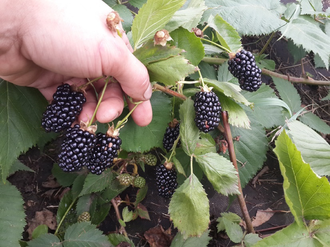 9.9 / 10
Rating
Reviews
I have this grade number 1. It ripens earlier than others, it goes well under cover, it is slightly affected by gray rot. The taste is sweet, but simple, and the aroma is subtle. |
|
Prime Ark Freedom
550 (two-year sapling with ZKS)
New remontant English brand besshipnaya blackberry. In the Middle Belt, autumnal fruiting does not have time to ripen, but early summer - pleases with excellent taste of berries. It is still at the stage of acclimatization, so the reviews are contradictory. Promising for commercial cultivation in greenhouses and tunnels. Refers to the typical cumanica with erect shoots. The berries are oblong-oval, one-dimensional, weighing 8 - 10 g, juicy, sweet with refreshing sourness. To taste surpasses other early popular varieties. Carry a good transport: not flowing and not wrinkled. Despite the recommendations to grow in the southern regions or in greenhouses, gardeners from Ryazan, Kazan, Moscow get good results both in the greenhouse and in the open ground with temporary shelter. Main advantages:
Minuses:
|
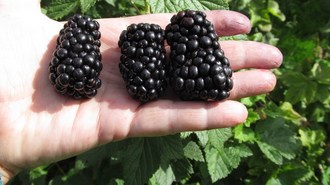 9.8 / 10
Rating
Reviews
Large berry with excellent taste, but freezes. To have a stable crop, it is necessary to plant in the greenhouse. |
|
Chester
480 (sapling with ZKS, wholesale price when ordering from 10 pcs.)
American bearless variety of late-ripening blackberry with extended fruit bearing. Shrub of a semi-wadding type: erect shoots with age tend to sag under their own weight. Shoots 2.5 - 3 m long, with strong branching. Formed on the trellis.The berries are round, variegated, weighing from 5 to 8 g, blue-black, dense, transportable, sweet and sour with interesting notes on the palate. Abundant rains impair the taste and quality of the berries. Shows high frost resistance: in the middle zone without shelter, only the kidneys freeze out in severe winters. For a stable harvest requires shelter. Well responds to dressing and competent care. Main advantages:
Minuses:
|
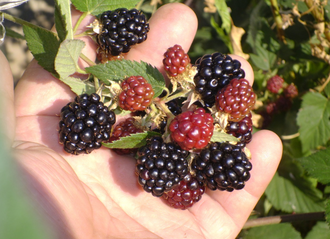 9.8 / 10
Rating
Reviews
Definitely need to have this sort of blackberry in the collection, if the conditions of the region allow the berries to ripen. Like for yield and taste. |
|
Polar
350 (one-year sapling, ZKS)
Polish blackberry variety of medium ripening for amateur and industrial berries. Refers to the typical cumanica. The bush is upright, gives powerful tough stiff shoots without thorns. The length of the shoots is 2.7 - 3 m. The preferred type of forming is a fan. The plant is quite compact. The berries are the correct oval shape, one-dimensional, with black gloss, weighing 9 - 11 g, medium density, sweet with a slight acidity, without tartness, with a bright aroma. Differ in good transportability. The level of winter hardiness is sufficient for growing in the middle zone with shelter. Promising variety of blackberry, always present in the list of recommended varieties for Moscow and Leningrad regions. In the Ulyanovsk region is considered a reliable variety, instead of shelter shoots just bend down to the ground. Main advantages:
Minuses:
|
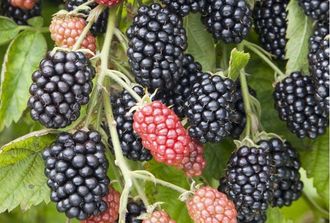 9.8 / 10
Rating
Reviews
This blackberry annually pleases with a harvest of delicious berries. Sufficiently stable and productive variety. |
|
Natchez
500 (biennial seedling in a 0.5 l container)
Bearing early American blackberry variety with prerequisites for commercial cultivation. At the beginning of growth, the bush is upright, but then the shoots acquire the properties of creeping forms. The shoots are fragile, without limiting the growth grow to 4 - 6 m, so for the shelter you need the correct shaping. The berries are oblong-cylindrical, 4–6 cm long, blue-black, glossy, weighing from 9 to 14 g, medium density, juicy, sweet with sourness and tartness, with a delicate aroma. When overriding, they do not soften and do not crumble. Well tolerated shipment and can be stored in the refrigerator for up to 2 weeks. Fruiting is stretched, which is a plus for a superearly variety. Winter hardiness is average, in severe winters and with a cold snap, even under shelter, kidney death is observed. There is evidence of susceptibility to anthracnose. Very good variety of blackberry for the middle band and the suburbs. Main advantages:
Minuses:
|
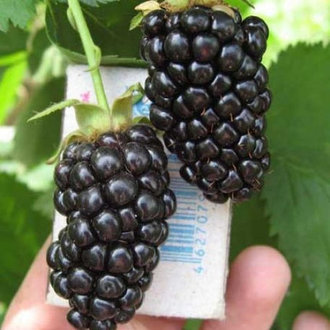 9.8 / 10
Rating
Reviews
The berry is marketable, but the seeds are very large for me. When sheltering shoots often break. |
|
Thornless Evergreen
1 000 (2-year-old sapling in a container)
Evergreen American late-ripening blackberry variety. It has a high decorative effect due to carved openwork leaves. Shoots without thorns, creeping type, flexible and fit well under cover. The bush has a high growth force. At damage of root system gives thorny growth. The berries are round, matte, weighing 3 - 5 g, sweet with a pleasant sourness. Suitable for refrigerated storage for several days and tolerate transportation well. With late ripening and extended fruiting in adverse years there is a risk of losing part of the crop. Winter hardiness is good, but is grown with shelter. Main advantages:
Minuses:
|
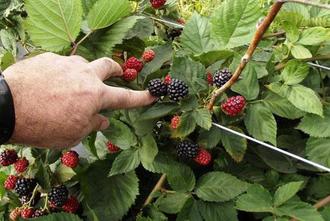 9.8 / 10
Rating
Reviews
In the Moscow region, this blackberry does not always have time to ripen and give the entire crop, but you can eat berries of excellent taste before the cold. |
|
Guy
350 (one-year sapling with ZKS)
Next in the ranking of the best varieties of blackberry - Guy, a new medium-early Polish variety with high taste. Bush upright, formed with a garter on the trellis. Shoots without thorns, reach 3 - 3.5 m. The berries are broadly oval, black with gloss, with an average weight of 6 g (up to 15 - 16 g). The flesh is elastic, sweet with delicate sourness, the taste of mulberry is felt, and some note notes of cherry. In terms of frost resistance at a high level among importless blackberry-free varieties, but it requires a mandatory cover to preserve flower buds. In the open field does not suffer from pests and diseases. The variety is recommended for cultivation in the Moscow region and more southern regions. Main advantages:
Minuses:
|
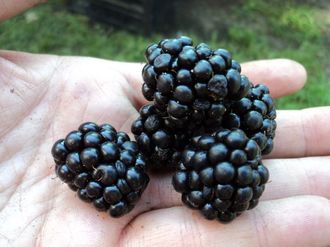 9.8 / 10
Rating
Reviews
The household likes the taste very much, the harvest is a pleasure: the berries are beautiful and large. |
|
Tornfree
490 (two-year-old sapling in a 5 l container)
Old American Besshipny late-ripening blackberry variety. The bush is semi-upright, grown on a trellis. Shoots up to 5 - 6 m, tough, stubborn. The berries are oblong-oval, one-dimensional, black with gloss, weighing 5 - 7 g, numerous in a brush (up to 30 pcs.), Sweet with a pleasant sourness and delicate aroma. Good for recycling and freezing. Suitable for intensive growing technology. Responsive to feeding and care. Planting in the penumbra give sour and watery berries. To facilitate the process of shelter during the growing season, nip and phased removal from the support. Coloring is not an indicator of maturity: blackened berries must reach for a few more days. The sweetest berries that come off freely and fall into the hand. In the conditions of the Moscow region often does not ripen. Prolonged rains lead to the development of gray rot and softening of the berries. This variety of blackberry has proven itself in the Samara, Orenburg and Volgograd regions. Main advantages:
Minuses:
|
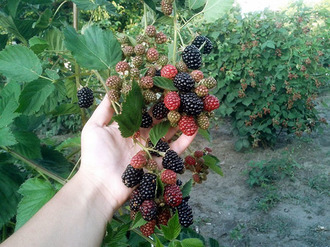 9.7 / 10
Rating
Reviews
When fully ripe, the taste is at a high level, the bush is very tall and quickly comes to full fruiting. |
|
Karaka Black
1 000 (2-year-old sapling in a container)
Early maturing New Zealand variety of barbed blackberry for amateur cultivation. Fruiting stretched for almost 2 months, goes in waves. Creeping shoots, 3–4 m long, flexible, easy to fit under cover. Thorns are medium in size but numerous and tenacious. The berries are oblong with a slight narrowing, cylindrical, black with shine, weighing 8-10 g, dense, sweet-sour, with a characteristic aroma that changes in intensity depending on the degree of maturity. Berries are transportable and suitable for storage. When overriding, it becomes fresh and watery. Frost resistance is low, so the use of shelter is mandatory. Grown in the middle lane. Main advantages:
Minuses:
|
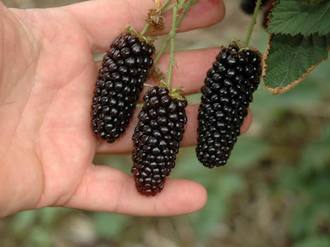 9.7 / 10
Rating
Reviews
The variety is noteworthy, but in adverse years and without top dressing it gives sourish berries. |
|
Agave
280 (one-year sapling with ZKS)
Reliable North American prickly blackberry variety. Ripening is more late. A plant with aggressive growth and strong root system, giving abundant growth. Shoots are upright, arched, up to 3 m long, covered with large spikes.Potential productivity is very high, but in order for the berry not to shrink, bush formation and rationing of the crop is needed. Berries weighing 4 g, delicate texture, fresh-sweet taste. When fully ripe berries are gaining sweetness, but become non-transportable. In the immature form there is a grassy taste. Differs in unpretentiousness in leaving and endurance to drought, frosts, remoistening, shading. In most regions, grown without shelter. It is resistant to pests and diseases. Main advantages:
Minuses:
|
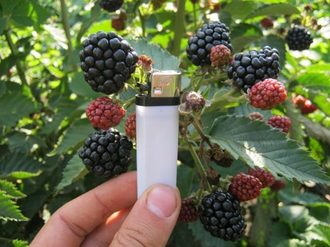 9.7 / 10
Rating
Reviews
Very good blackberry variety, always with a crop that manages to ripen in the conditions of the Moscow region. |
Unlike raspberries, most varieties of blackberry (except Agaveam) do not produce root shoots, provided that the surface root system has not received mechanical damage. Therefore, digging and frequent loosening of the blackberry bush is highly undesirable. Blackberries are resistant to podprevaniya, but a long contact of the shoots with wet soil, however, is unacceptable.
Growing blackberries in the middle zone is associated with certain risks. In studying the recommendations for growing need to pay attention to what region they are calculated. For example, the placement of landings in the penumbra is true for the south, where the berry is strongly baked, and for the Middle Strip it is necessary to allocate a sunny place for the blackberry with protection from the winds. There are different ways of shaping, and features of care.
Have a good harvest!
